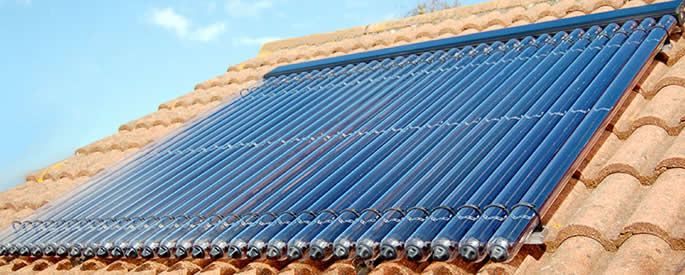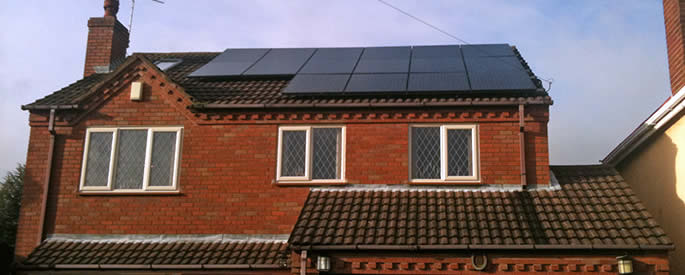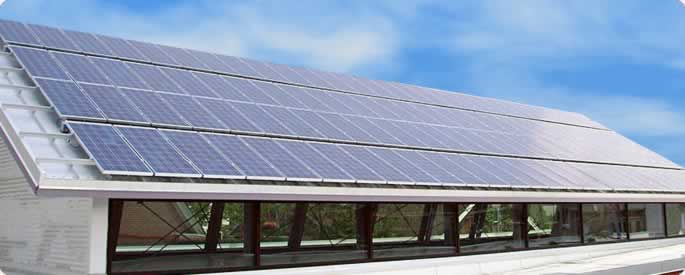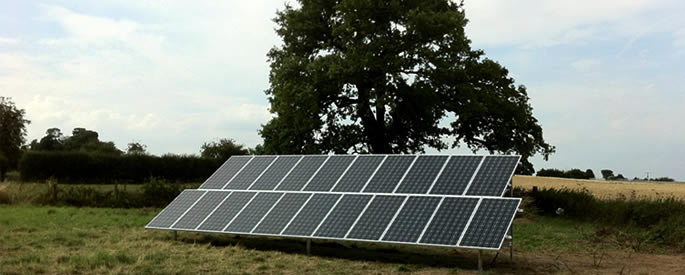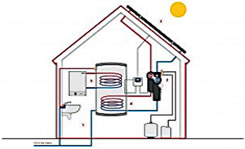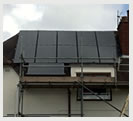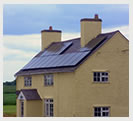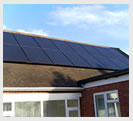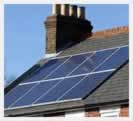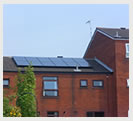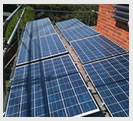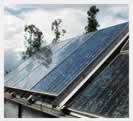Types of Solar Thermal Heating Panels
Telephone
01562 228177
Types of Solar Thermal Water Heating Panels
How it works
Solar thermal systems use the sun's energy to heat your water. The collector plates on your roof absorbs the suns energy and they transfer this into either glycol or directly into the water from your tank. It's then pumped along pipes to your hot water cylinder, heating up the water to a preset temperature. In the winter months (Dec, Jan, Feb) Your boiler or immersion heater then tops up the heat as needed, bringing the water to the temperature on the thermostat.
A solar thermal system will work best in summer, when it can produce up to 100% of the hot water you use. But it will still save you money all year round, and thanks to the government there is soon to be a financial incentive from the RHI payments. It is worth checking out the heat pump option in the A Different Solution tab
The Technology
Every solar thermal system is made up of a solar panel (collector plate), a hot water cylinder, a pump and a controller. You will also have a boiler or immersion heater to back up the system.
There are two types of thermal solar collector plates: flat-plate collectors and evacuated-tube collectors. Evacuated-tube collectors are slightly the more efficient of the two, as they can produce slightly higher yields in autumn and spring. However, the amount of hot water both types of collector produce is very similar.
Flat-plate thermal collectors are good value, last a long time and need very little maintenance. They also sit a little flusher with your roof.
Evacuated-tube thermal collectors have a higher efficiency than flat-plate collectors, so they may be a good option if space is an issue. They can also be mounted in almost any orientation, from a flat roof to a wall. So even if you already have PV panels covering your roof, you may still be able to fix a solar thermal collector to a south-facing wall.
Your hot water cylinder will need to have a twin coil heating system. The lower coil is heated by the solar thermal system and the controller manages the upper coil by your boiler, the pump. It reacts to the temperature of the fluid in the solar collector and the water in the cylinder to automatically determine the rate at which the fluid is pumped around the system.
Is my Home Suitable for Thermal Panels?
As long as you own your house and have enough space for thermal panels on your roof or wall, there's a good chance you'll be able to benefit from a solar thermal system.
Solar thermal can work with most existing heating systems, and there is a system that will work with a Combi boiler.
The criteria for thermal panel systems are similar to PV but they are a little more forgiving. Ideally you need a southish facing roof with space for the collector plates, preferably with little or no shading.
Hot water cylinder
You will need to have a water cylinder for solar thermal panel heating system, but with the increase in efficiency these cylinders can be smaller than they used to be.
Costs and Bill Savings
Solar thermal technology has lots of advantages – it's low maintenance, it will save money year after year and the system is relatively inexpensive when compared with heat pumps.
Costs
The cost of your install will depend on a range of factors including the number of panels, the complexity of the plumbing and the suitability of your existing hot water system. A typical Abbey system would cost between £3,500 and £5,500, and you'll be able to get £300 towards this from the government as part of the upcoming Renewable Heat Incentive.
Savings.
Depending on how you use it, a well-designed and properly sized solar thermal system can help you make a substantial saving on your bills. You can expect it to provide:
- 100% of your hot water in the summer.
- 60-100% of your hot water in the spring and autumn.
- 10-40% of your hot water in the winter.
You'll make the biggest saving if your hot water is currently controled by electricity, followed by oil and LPG and then mains gas.
Collectors - general background.
There are two types of collector: flat plate collectors and evacuated tubes.
Flat Plate Collectors.
Flat panel collectors are composed of insulated flow tubes encased within an absorbing plate and surrounded by further insulation. This is all enclosed within a frame, usually aluminium or galvanised steel, and a transparent cover. The heat transfer fluid travels through the flow tubes and is heated, and then warms the domestic water.
Evacuated Tube Collectors.
Evacuated or Vacuum Tubes are so called because the absorber sits in a vacuum, significantly reducing the heat loss, particularly in cold weather.
The tubes are made from glass - typically ultra-strong and heat resistant Pyrex with a double wall construction. The glass on the inner tube is coated on its outer surface with an absorbent coating, and on its inner surface with a reflective coating. Inside each tube is a copper heat pipe containing a glycol / anti-freeze mixture.
There are two types of evacuated tube collector: "direct flow" and "heat pipe"
In direct flow technology, the fluid running through the copper tube is pumped all the way around the system, passing through the heat exchanger in the cylinder, and thus transferring its heat directly to the water in the cylinder.
In heat pipe technology, there is a second 'fluid circuit' running through the manifold (top) of the tubes. The fluid in the copper heat pipe in the tube is sealed off from the fluid in the manifold. As the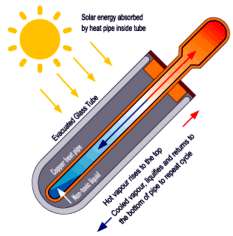 tube gets hot, the liquid in the copper heat pipe is vaporised; the hot vapours rise to the top of the heat pipe where the copper tip connects with a header pipe through which the manifold fluid flows. The heat passes from the vapour to the manifold fluid. The manifold fluid is then pumped through the heat exchanger in the cylinder.
tube gets hot, the liquid in the copper heat pipe is vaporised; the hot vapours rise to the top of the heat pipe where the copper tip connects with a header pipe through which the manifold fluid flows. The heat passes from the vapour to the manifold fluid. The manifold fluid is then pumped through the heat exchanger in the cylinder.
The copper at the tip of the heat tube can reach well over 200 degrees easily heating water to 90 degrees Celsius on hot days and to 60 degrees Celsius even in the winter. This simple system is completely sealed and needs minimal maintenance over its 20+ years life.
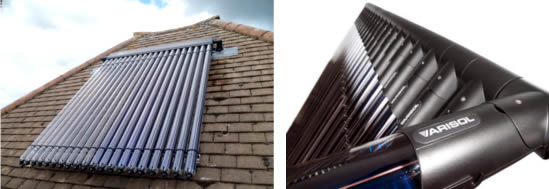
heating system diagram
PV We Recommend & Install
With the most powerful solar energy systems on the planet you can significantly reduce your electricity bill.
Customer Testimonials
Brian Whitehouse
"Just to say I would thoroughly recommend Abbey Solar if you were thinking of installing a solar panel system. It was completed in a day and with no fuss or traumas"
Stourbridge
Mr Hemming
"It was a pleasure dealing with Abbey. They were very professional and did not employ the double-glazing tactics unlike the other companies we had round"
Kingswinford
Roger Penn
"The salesman from Abbey was very knowledgeable about all aspects of renewable technologies and gave all the information we needed to make a decision about whether to proceed"
Kidderminster
Dr Singh
"Abbey did a superb job on our property and I would recommend them to anyone considering having a solar installation"
Wolverhampton
Mr Hateley
"We had our PV system installed by Abbey and I would have no hesitation in recommending them to everybody"
Birmingham
Daniel Johnson
"We installed a 10kW system. The system performs better than Abbey said it would and we would use them again – in fact we had infra red installed as well"
